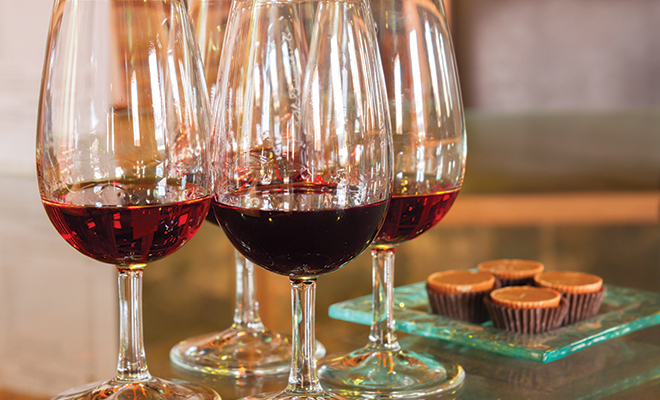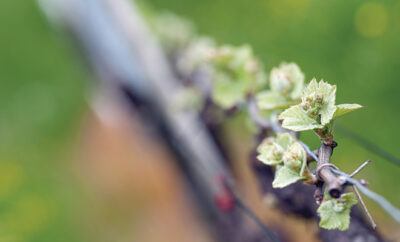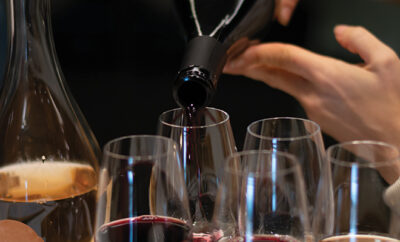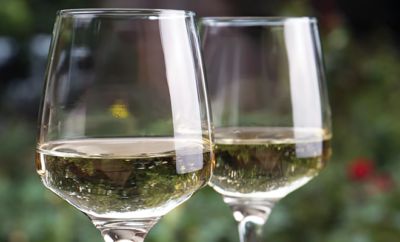
Dolce vita–sweet life!
Blame it on Cupid or fabled stories of love spurred by magical chocolates and sweets! It’s the time of year when jewelry stores, chocolatiers and wineries pair their wine offerings with truffles, bittersweet bits and items dipped in various confections with dessert wines and ports.
Although February tends to have the calendar focus for these pairings, they have thrived for centuries. Enjoying a sweet bit of libation around mealtime is a tradition for many cultures, whether it’s a cream Sherry after dinner or the more food-friendly Riesling served with or without a meal. Typical dessert wines contain at least 14 percent alcohol, and these days table wines can be found with 15 to 16 percent alcohol, which can make their distinction from dessert wines a bit challenging. Wine grapes that are kept on the vine past regular harvest are good possibilities for dessert wine; Rieslings, chardonnays and viogniers make lovely late harvest dessert wines, but they also have a food-friendly function when bottled as regular still wines.
Why is the alcohol level of the wine important? During fermentation, the alcohol levels rise. Higher sugar content in the grapes when they’re harvested generally results in higher levels of alcohol. Table wines range from 9 to 11 percent alcohol by volume. White wines and red wines with moderate levels of alcohol will pair well with meals and not overpower the palate with alcohol. Recently, however, these levels have been increasing even in the cabernet sauvignons, malbecs, syrahs and zinfandels, often landing in the 15 to 16 percent range, which affects their companionship with food. White wines such as chardonnay and sauvignon blanc have retained their usual levels under 12 percent, making them very food friendly. Nevertheless, the rising alcohol levels have spurred many discussions on the subject of properly classifying today’s wine offerings for the consumer’s discernment.
Ports and dessert wines are a great way to enhance your meal or holiday gathering. Due to the density of flavor and alcohol, ports and dessert wines are often served in cordial glasses or snifters rather than a standard wine glass. Because fortified wines have the additional enhancement of brandy in the fermentation process, the intense sweetness of port can make it a dessert of its own, but it’s often paired with dense, rich and intensely sweet chocolates and desserts.
Port, although fortified, is aged as is any other red wine. The styles of tawny and ruby port differ by age but also in how they’re stored during the aging process. Ruby port is brighter in color and aged less than five years in airtight non-oak containers such as stainless steel or even ceramic vessels before bottling. The taste is lighter on the tongue with bright berry. Tawny port, on the other hand, has been aging in oak barrels, picking up deep toasty flavors while oxygen circulates through the aging process. When you pour two cordial glasses side by side, the darker color of the tawny port illustrates the age difference from ruby port.
Buying port can be a fun exercise in geography. When you see Porto on the bottle, it denotes that the red wine grapes came from a region in Portugal named Douro. If the grapes didn’t originate in Portugal, you’ll often find the words “dessert wine.” Aside from this distinction, some vineyards have been grandfathered to allow the use of “port” due to vineyard lineage and other factors. That’s always an interesting conversation to have with your favorite winery or wine shop.
Whether you’re celebrating Valentine’s Day or the Super Bowl, enjoy the season’s sweets by exploring ports and dessert wines as a fun adventure for your palate! HLM
Sources: decanter.com and wineanorak.com.
Quick Guide to Dessert Wines
A port by any other name is a dessert wine. Look for these favorites at your local wine shop:
Sancerre is a pleasant, sweet white wine, a surprising little gem with blue cheese, almonds, figs or apricots for dessert. It’s also lovely to sip on while selecting your appetizer.
Madeira wine, also derived from Portugal and rumored to be Thomas Jefferson’s favorite toasting wine, pairs with cooked fruits such as baked apples, pears and dates.
Sherry is a classic that can be confused with the dry version used for cooking. Serve it not too chilled with your most steadfast cheeses such as truffle cheddar or triple crème blue cheese.
Ice Wine is delightfully credited to the German culture; grapes are left on the vine past late harvest to increase their sweetness with the cold temperatures. If you love making homemade apple donuts or strudel, this is a great treat.
Late Harvest wines made from chardonnay, viognier and Riesling have intense floral and honey components, making them perfect additions to desserts, cheeses and fruits.







